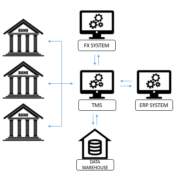Mergers & Acquisitions: The 26 process steps for a corporate treasurer
| 29-5-2017 | Theo Paardekooper |
 The main task of a treasurer is linked to cash management and short term funding and investments. This is the common practice in the Dutch corporate market, but this is by far not the right view on treasurer’s tasks and responsibilities. In the UK and USA the treasury function is more based on a position close to the CFO, being responsible for the corporate financial strategy and being an advisor for the financial framework of a company. A treasurer is more than a operational position in the company.
The main task of a treasurer is linked to cash management and short term funding and investments. This is the common practice in the Dutch corporate market, but this is by far not the right view on treasurer’s tasks and responsibilities. In the UK and USA the treasury function is more based on a position close to the CFO, being responsible for the corporate financial strategy and being an advisor for the financial framework of a company. A treasurer is more than a operational position in the company.
One of the topics on the agenda of the treasurer is the merger and or acquisition strategy of the company. This blog gives you a short guidance in the 26 steps in selling (or buying) a company.
26 process steps
The treasurer will join a team of experts to execute this process.
Step 1. Market research. This research will give a clear view on the market to collect sufficient information for the management to make decisions during this process. Mostly a request for information is launched to candidate advisors that will be used in this sales process. These advisors will give a snap shot on the transactions containing information that is used in the Steps 2, 3, 4 and 5.
Step 2. Track record. Investigate the track record of the advisors involved in this process.
Step 3. Valuation of the company compared to its peers. Valuation can be based on Discounted Cash flow, EBITDA-multiples or Net asset Value.
Step 4. Prepare a Long List of possible buyers (or targets). This list can contain strategic buyers (competitors or companies in the same value chain) and financial buyers (private equity and hedge funds).
Step 5. Negotiate a fee structure for the mandate holders of the transaction, the investment banker, legal and tax advisor.
Step 6. Contact program prepared for the parties on the Long List on an anonymized basis. The name of the selling company is not (yet) mentioned in any contact with parties on the Long List.
Step 7. After establishing the first contacts in the markets a Short List will be prepared containing up to 15 possible candidates
Step 8. Preparing a teaser and a non-disclosure agreement. (NDA)
Step 9. An investment memorandum will be submitted to potential buyers after accepting an NDA.
Step 10. A process letter will be distributed containing the time frame and schedule for the next steps in the buying (or sales) process.
Step 11. Non-binding offer launched by the buyer including a data room request. This non binding offer contains at least: – a price and/or pricing mechanism, – information about the buyer and its representatives, – specification of the deal (buying in cash, shares, earn-out, vendor loan etc.) and other requests for information that are required to launch a binding offer
Step 12. The bidder will arrange a bank financing agreement or term sheet.
Step 13. Assessment of the bids by the seller. To a maximum of 5 possible candidates will be assessed.
Step 14. Send an invitation to organize a due diligence. This due diligence will be related to the domains of legal, fiscal, financial, Human Resources, intellectual property, environmental and commercial items. A data room will be available for the potential buyers. Management of the selling company and management of the buying company will give management presentations. Also site visits can be part of this process. The due diligence reports will show the risk, the impact of these risks and the possible actions to mitigate this type of risk.
Step 15. Golden parachutes. Offer to key managers in the target company who probably will not “survive” after the transaction but who will be important in de selection process.
Step 16a. Launch of a binding offer including reservation to final approval by the banks and shareholders of the buyer.
Step 16 b. Presenting term sheet of banks showing the financing capabilities of the buyer to close the deal.
Step 17. Start the approval/advise process to inform formal regulators and the employee’s council of buyer and seller.
Step 18. The seller will send a term sheet/heads of terms to the final preferred bidder (or 2 bidders)
Step 19. The seller gives exclusivity rights to one or two preferred bidders for a period of 3-4 weeks to negotiate a Sale Purchase Agreement (SPA) or an Asset Purchase Agreement (APA).
Step 20. Negotiation of SPA or APA containing:
Price and pricing mechanism about corrections on working capital, debt and cash position and conditions precedent.
Representations (Reps). A declaration of the seller about all the information submitted to the buyer. This information can’t give any reason for discussion or claim after closing.
Warranties, valid for a defined period containing a defined amount to cover certain risks
Step 21. Signing
Step 22. Closing. Transfer of shares from seller to buyer
Step 23. Settlement of share price payment after pre defined calculation of the price as defined in the pricing mechanism.
Step 24. Placing of funds on an escrow account, established to cover the warranties given buy the seller.
Step 25. Closing of accounts that were used for settlement. In the Netherlands a notary public is used in the settlement procedure, but this is not the process in other countries.
Step 26. 18 months after closing. Release of the escrow funds to the seller.
These 26 steps are a framework, but some steps can be merged in one process step. The position of the treasurer in this process is linked to his experience and his position in the management of the company.

Independent treasury specialist











